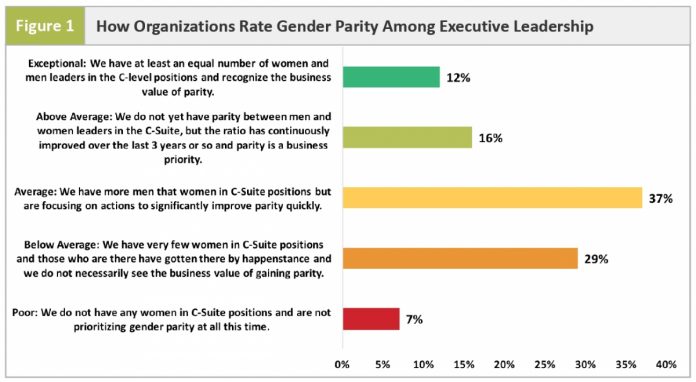
Workplace equality between the sexes has long been a challenge for organizations worldwide. Women make up almost half of the workforce, yet the majority of them still are not receiving equal compensation or equal opportunities to develop and advance. While progress has been made through awareness efforts and education, a challenging environment still exists for women—and especially for women leaders aspiring to executive leadership roles. When respondents to Brandon Hall Group’s 2016 Women in Leadership Study were asked to rate their organizations on gender parity, 12 percent said they had an equal number of men and women in C-level positions. Figure 1 below shows the breadth of the gender parity problem among the executive ranks.
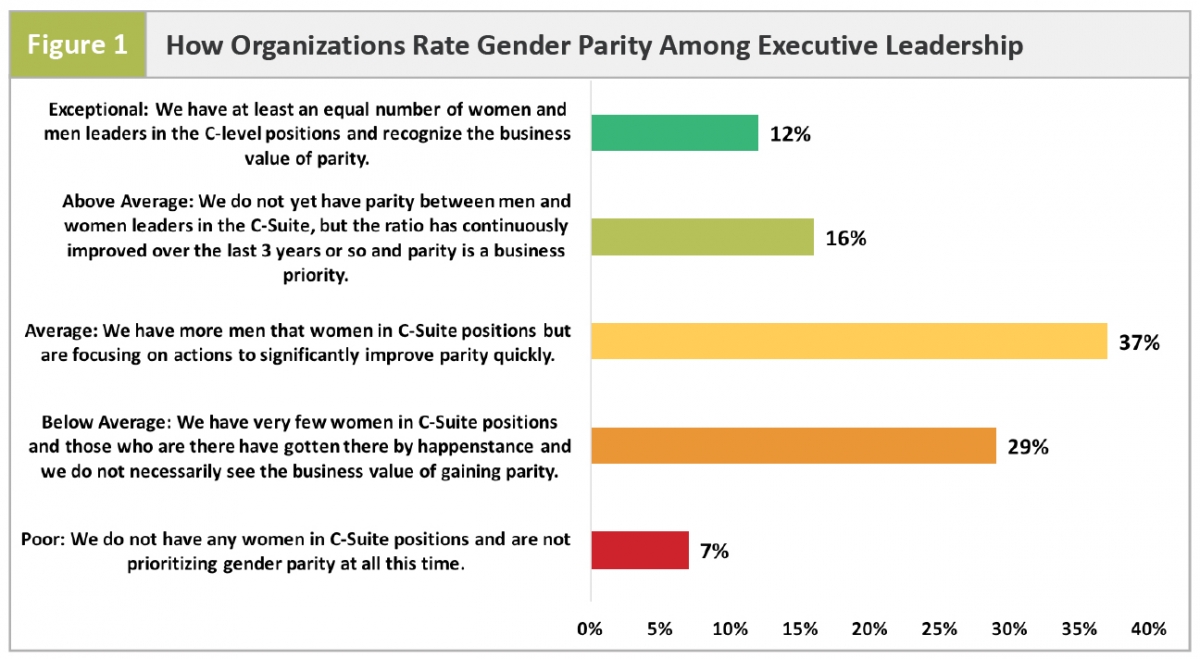
Source: 2016 Brandon Hall Group Women in Leadership Study (n=420)
Only 10 percent of organizations overall, and 12 percent of high-performing organizations, have women in at least 50 percent of C-suite positions. This is in spite of the fact that 97 percent of respondents say that the interest in having women advance to executive positions, including CEO, has remained the same or increased over the last few years. As shown in Figure 2, there are several barriers for women leaders to overcome, the most frequent one being inadequate management of the leadership pipeline.
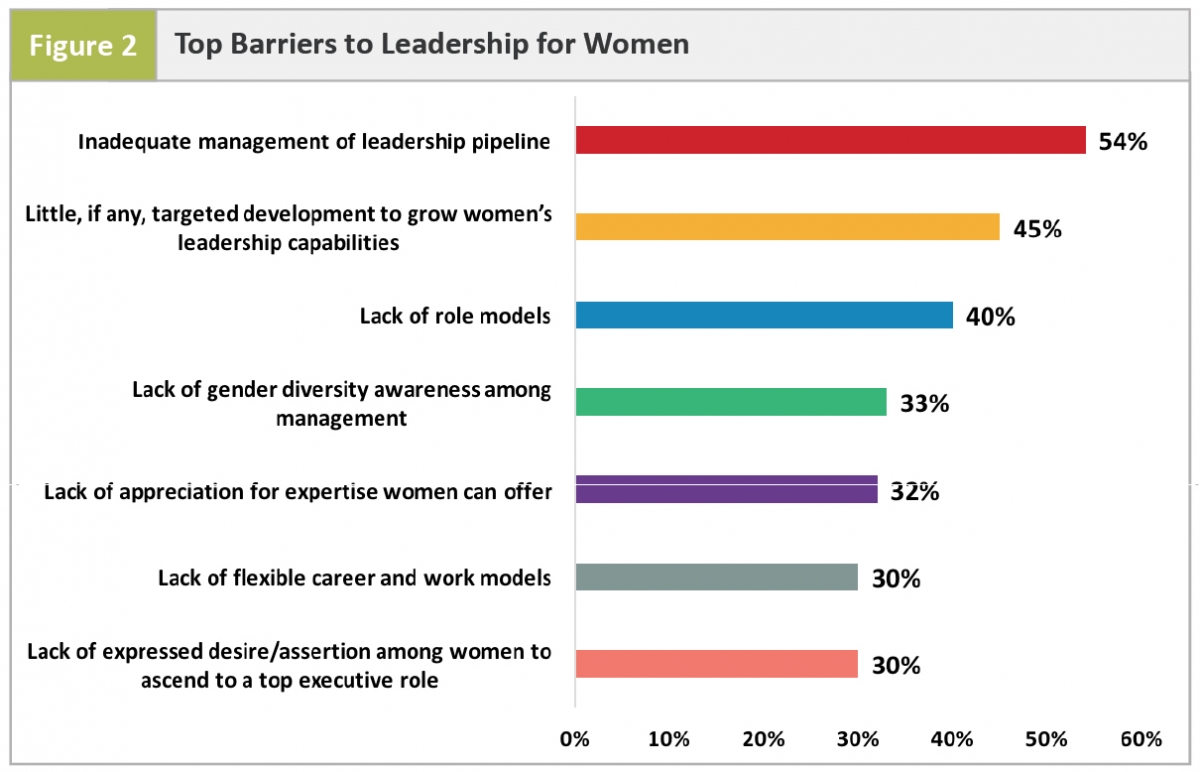
Source: 2016 Brandon Hall Group Women in Leadership Study (n=420)
Another major impediment for women leaders is a lack of development opportunities. Our findings also showed:
- 81 percent of organizations do not offer core women-in-leadership programs focused on critical skills training.
- 76 percent do not provide a mentoring program aimed exclusively at grooming women leaders.
- Three times as many organizations have no women or few women in C-level roles than have at least an equal number of men and women in those positions.
With diversity and inclusion being a critical initiative for many companies, one element of that is creating a culture and atmosphere for women to advance to, and excel in, leadership positions. We have seen great examples of diverse leadership teams cascaded throughout an organization. However, these examples are still too limited, and gender inequality continues to present a cultural divide among peers, creating distrust and friction that ultimately derail organizations from achieving their greatest potential.
“The heart is in the right place, but change is not happening as fast as it can. There are still a lot of cultural biases that often hold women back,” notes Sonia Dua, an India-based vice president at Genpact, a global business process management and services corporation.
This article is based on results of Brandon Hall Group’s 2016 Women in Leadership survey of 420 respondents from 26 countries and more than 30 different industries, plus more than 25 interviews with women leaders.
The Challenges of Gender Parity
Our research survey asked respondents to respond to a series of statements that indicated their organizations’ level of commitment to enabling the development of women for key leadership roles. On only one statement—“Our culture embraces women in leadership roles” —did more than half of respondents (58 percent) answer in the affirmative. Only 45 percent of organizations indicated that they made a “good effort at advancing women into senior leadership roles.” These and other responses illustrate how far most organizations have to go to create a culture that supports gender parity in top leadership roles.
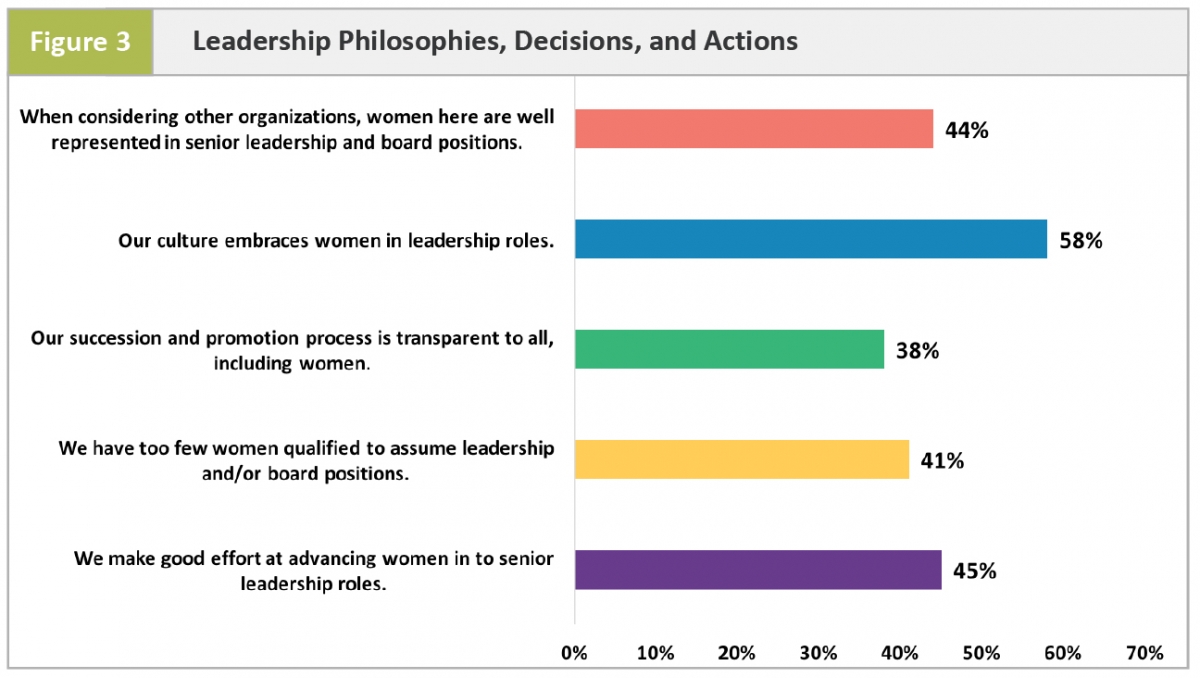
Source: 2016 Brandon Hall Group Women in Leadership Study (n=420)
In subsequent interviews with several research respondents, they explained the challenges they face in developing women leaders. Here is a composite of a variety of responses:
- Business must find the right talent that matches the culture of the organization. Many younger women go to school and may get degrees that match certain careers, yet will join the company and if certain departments are still male-dominated or the culture is non-collaborative and controlling, the majority will shortly leave the organization. Reasons include the stress of the job, feeling inadequate or not part of the team, not knowing how to communicate efficiently and set proper expectations for boundaries, and factors within the company that conflict with their definition of work-life balance.
- Managers don’t want to hire or promote individuals based on gender, but want to find the best qualified person. If a proper selection and grooming process is not in place to manage recruiting and succession planning, organizations tend to follow the same male-dominated hiring patterns.
Targeted Development of Women’s Leadership Capabilities Is Minimal
Some 45 percent of organizations are not offering or supporting targeted development opportunities for women. While we know leadership development has been adopted by many organizations, the programs do not intentionally target women for development and advancement. Whether by overt or inadvertent exclusion, this is leading to a lack of representation of women in higher-ranking positions. This was the most common issue for small organizations with fewer than 1,000 employees.
Lack of Role Models
Four in 10 companies believe a lack of role models is to blame for low utilization of women in C-level positions. It’s no surprise that this is a contributor since just 14 percent of companies have a female CEO, and there is low penetration in the C-suite, as well. Great leaders need to incorporate a sense of their style; however great leaders—men and women—all have had inspiring mentors and role models who they have aspired to be like. Women still struggle to find role models they can relate to and learn from.
Lack of Gender Diversity Awareness within Management
Diversity training is the No. 1 targeted development opportunity offered exclusively for women. Approximately one-third of companies create a unique diversity and inclusion group dedicated to women leaders as a way to support the aspirations of this segment of the workforce.
Diversity programs, if not delivered carefully, can lead to continuing separation among genders and ethnicities in the workplace. The purpose of the programs is to create awareness around gender biases, and solutions to effectively deal with them.
Breaking Through Barriers
The most encouraging piece of our Women in Leadership research revolves around the ways companies are making efforts to improve gender parity and the utilization of women in senior leadership positions. On the downside, in many cases these methods are not widely used, they are not blended with more effective methods, and they are not supported by top management and organizational culture.
That said, for companies that are trying to eliminate the gender disparity, the list below—along with insights and examples—provides a menu with great options to prioritize the growth and development of female leaders.
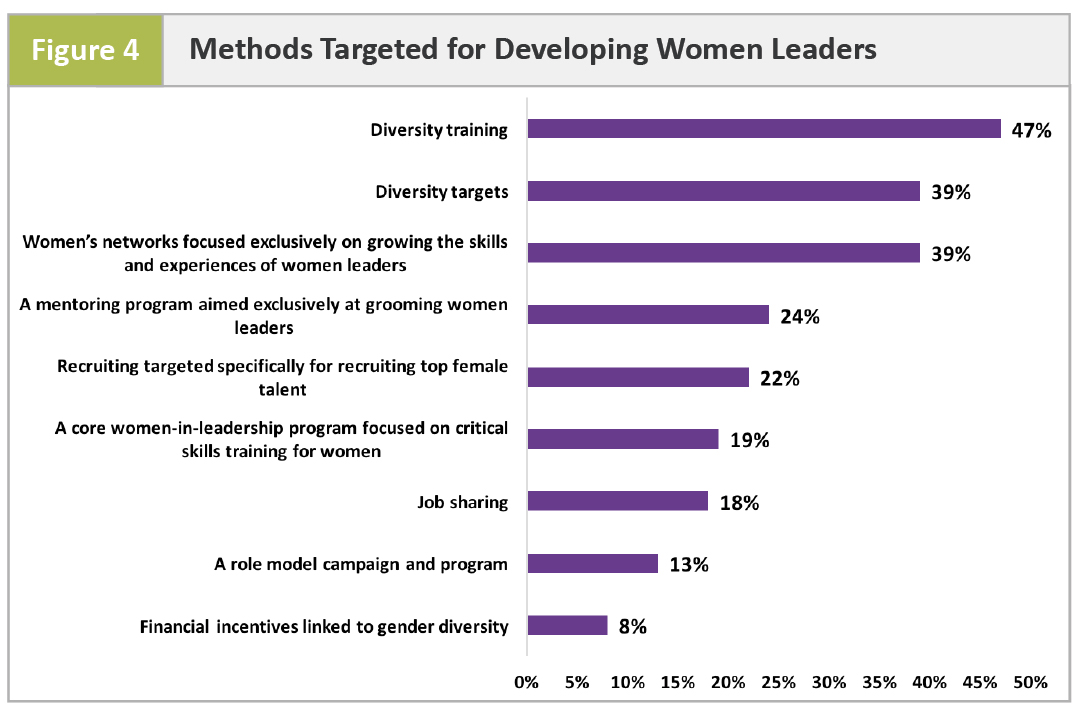
Source: 2016 Brandon Hall Group Women in Leadership Study (n=420)
Diversity Training
Nearly 50 percent of companies offer diversity training to help employees understand the value of a diverse workforce. If diversity training is not delivered well, however, it can have the opposite effect: Instead of creating awareness and inclusion, it can lead to further dividing genders or ethnic groups. But there are some companies, such as Genpact, that are bringing together women to address real issues and challenges that are unique to them.
Genpact’s Dua says her company has been proactive, through several training initiatives, to ensure that unconscious biases don’t creep in that can impact the workplace environment and create barriers to inclusion in hiring, promotion, and development.
Networks Focused on Growing the Skills of Women Leaders
Approximately 40 percent of organizations offer exclusive networking groups to bring women together to share and learn from each other, as well as inspire women leaders. Some companies even use special tactics to raise awareness of the women who are interested in climbing the executive ladder. The most common method is through simple networking groups (53 percent). Approximately one-third of companies create a unique diversity and inclusion group dedicated to women leaders as a way to support the aspirations of this segment of the workforce. This is relatively easy: It only involves laying the foundation and creating an environment where this type of community can flourish.
Mentoring Programs Exclusively for Women Leaders
Brandon Hall Group’s 2015 State of Succession Management survey confirms that succession management continues as one of the most important elements in ensuring leadership and business continuity, yet 84 percent of organizations still suffer from too little ready talent for critical roles. Only 37 percent of companies have women currently being groomed for executive positions. The No. 1 reason holding women back from C-suite roles is a lack of succession management for the leadership pipeline.
Lindsay Currie, director of Stakeholder Engagement at the Regulatory Affairs Professionals Society, says one of the biggest needs is mentoring specifically aimed for women leaders. “Although it’s hard to set time aside to accomplish this, it is one of the most vital pieces of being a successful leader,” Currie says. “It’s also important to have both male and female mentors—to gain different perspectives and acquire a variety of skills and advice. It also would be beneficial to have mentors in and out of one’s particular field.”
Offer a Core Leadership Development Program Specifically for Women
Only 19 percent of organizations offer leadership programs focused on critical skills training for women. The women leaders we interviewed for this report overwhelmingly agreed that there should be programs available to women to help them build the skills needed to succeed and advance in the workplace. However, these women leaders also stressed that development and mentorship opportunities that integrate men and women cohesively also are needed.
Through our survey and qualitative interviews with women leaders, we developed several topics that learning opportunities for women should include:
1. Confidence building
- Learn how not to continuously need or seek external validation.
- Learn not to underestimate capabilities. Women tend to underestimate their capabilities, and men overestimate, which can hinder women when asking for a promotion or raise or new project.
2. Conflict resolution
- Learn how to be persuasive.
- Learn how to give direct feedback—be clear in your purpose
3. Mentorships
- Men and women mentors can be very effective.
4. Coaching
- This includes scenario-based learning using real business situations to solve problems and drive creativity.
5. Women networking groups
- Some 53 percent of organizations find these systems helpful in building awareness for aspiring women leaders.
Brandon Hall Group’s Critical Calls to Action
For the Organization
- Educate and provide gender awareness and sensitivity training
- Offer coaching and mentoring programs
- Encourage in-house networking groups exclusively for women
- Encourage discussions around building bridges, discovering commonalities and developing empathy for genders, so they can appreciate each other in the workplace and communicate more effectively to drive greater results
- Ensure that your succession strategy does not hinder building your leadership pipeline; if you are not grooming, or identifying, enough qualified female candidates to advance, you need to rethink your succession and talent strategy.
For Aspiring Women Leaders
- Seek out opportunities to educate and challenge; yourself don’t accept the status quo
- Make sure your self-story doesn’t hold you back
- Be a role model and an inspiration to other women
- Become a mentor and create change
- Align and help shape the surrounding culture in your organization and community
Rachel Cooke is chief operating officer and principal HCM analyst at Brandon Hall Group, a human capital management (HCM) research and analyst organization focusing on Learning & Development, Talent Management, Leadership Development, Talent Acquisition, and Workforce Management/HR. She also hosts HCMx Radio, a weekly podcast. If you have a compelling story about women in leadership that you would like to share, please contact Cooke at success@brandonhall.com




